Author: admin
Enhancing the physical retail experience by converging offline and online at the store
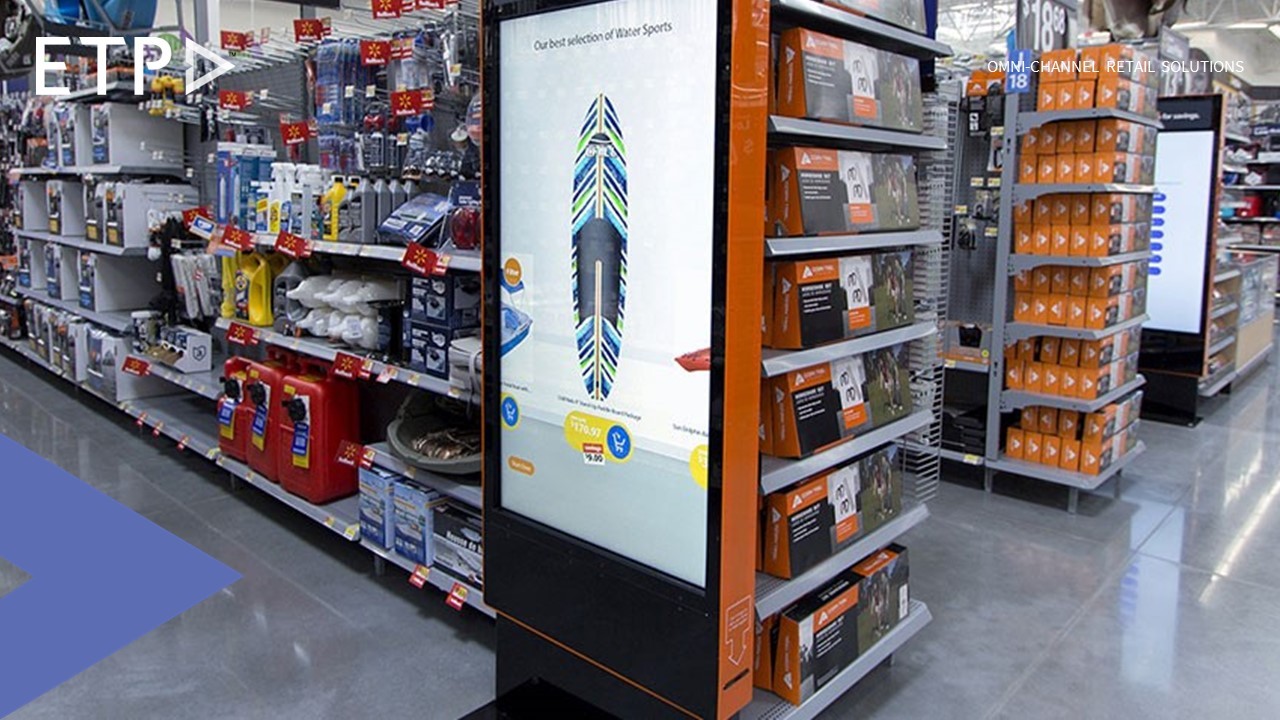
In the last year, physical retail has witnessed some of the most challenging situations. While some well-known retail chains filed for bankruptcy, some retail companies shuttered their stores, some retail companies closed down completely, while some others were struggling to keep up with the growing threat from e-commerce sites and this struggle seems likely to continue. Moreover due to a majority of customers owning a smartphone nowadays, the shift towards mobile and online purchasing will only increase.
With e-commerce and m-commerce being literally at their fingertips, shoppers are often looking to do their purchases with ease and with minimal efforts. This is one of the biggest advantage that online has over physical retail. Though brick and mortar stores provide that touch and feel experience to the shopper, this alone is not enough to compete every time with e-commerce. Therefore, physical retailers need to create a unique and awesome experience for customers and one of the most effective ways to do this is converging online and offline experiences at the store itself.
Retail companies like New York & Company have already begun converging online and in-store selling by using self-service kiosks allowing e-commerce access in some select stores. These effectively serve as a complement to the store associates and the traditional checkout area as the kiosks are positioned throughout the store or near the service desk. This provides the shoppers with the choice of self-service by accessing multiple touch-points across the store where they can shop from both the store’s physical and online product offering, make a secure purchase and collect or get their order shipped directly to any address. This expands the retailer’s point of sale capabilities thus giving customers tech options that they intuitively already know how to use as well as makes the shopping process quick and convenient.
For retail companies wanting to create an omni-channel shopping environment, such self-service kiosks or mobile and other handheld devices that allow shoppers to browse and choose products on the online site while they’re already in the store are definitely apt. Adding this omni-channel capability can help retailers prevent a loss of sale situation if an item is out of stock at that particular store, while still allowing the store to get credit for that particular sale.
Having said that, the kind of technology a store should incorporate depends on the type of store, its product offerings and its customers’ tastes and preferences. It can be overwhelming to choose from the wide range of in-store technology for e-commerce available. Retailers need to research which technology to choose, how to incorporate it and accordingly should drill down to what they’re looking to get out of it, and make a smart and well-informed decision before making an investment.
Some of the considerations for incorporating endless aisles in-store technology could be:
Limited space to display inventory, but a large product offering
Having a well-designed online site that can be easily accessed online
Type of hardware depending on the store space – kiosks or handheld devices
Required infrastructure for managing online functionality within the store
The benefits it would provide to the customers, store staff and the business
The best way to start is to proceed with an inside-out approach that retailers can use. Understanding their own business needs and objectives first and then taking inspiration from peers will prove to be a good modus operandi for them to take better decisions. A good omni-channel retail solution with the right capabilities can help retailers attain higher productivity and better customer loyalty.
Applications of AI in Retail
Application of AI driven process in retail will not only help retailers acquire new customers, but also boost repeat business. Increased accuracy in personalized communication to the customers along with tailored recommendations and offers will compel shoppers to strengthen their loyalty as they will begin to associate the retail brand with personalized, relevant experiences. Having realized this, retailers are looking to invest and use AI heavily in this coming year
According to a research, global spending on Artificial Intelligence (AI) in retail is expected to grow nearly fourfold over the next four years, from $2 billion in 2018 to more than $7 billion in 2022. This is expected to happen as retailers look at new avenues to boost their efforts to offer personalized customer experiences. As such, retailers will heavily invest in AI tools that will allow them to differentiate and improve the services they offer to their customers. These tools, ranging from automated marketing platforms that generate tailored and timely offers, to chat-bots or voice assistants that help to provide instant customer service, will be in the radar of retail brands.
Progress in AI and machine learning in the recent years gone by and those to come will be exponential. The combination of AI, cloud, Big Data have already begun the transformation of the retail industry and this will reach new levels in the near future. As AI leverages big data to personalize experiences, retail companies are looking at these applications to garner robust competitive advantages. As per the report, retailers’ spend will be the strongest in the customer service and sentiment analytics area to understand customers’ reactions to the products purchased and the service received, all being possible with the application of AI in analytics. This will prove to be the breakthrough for retailers looking to improve their customer experience.
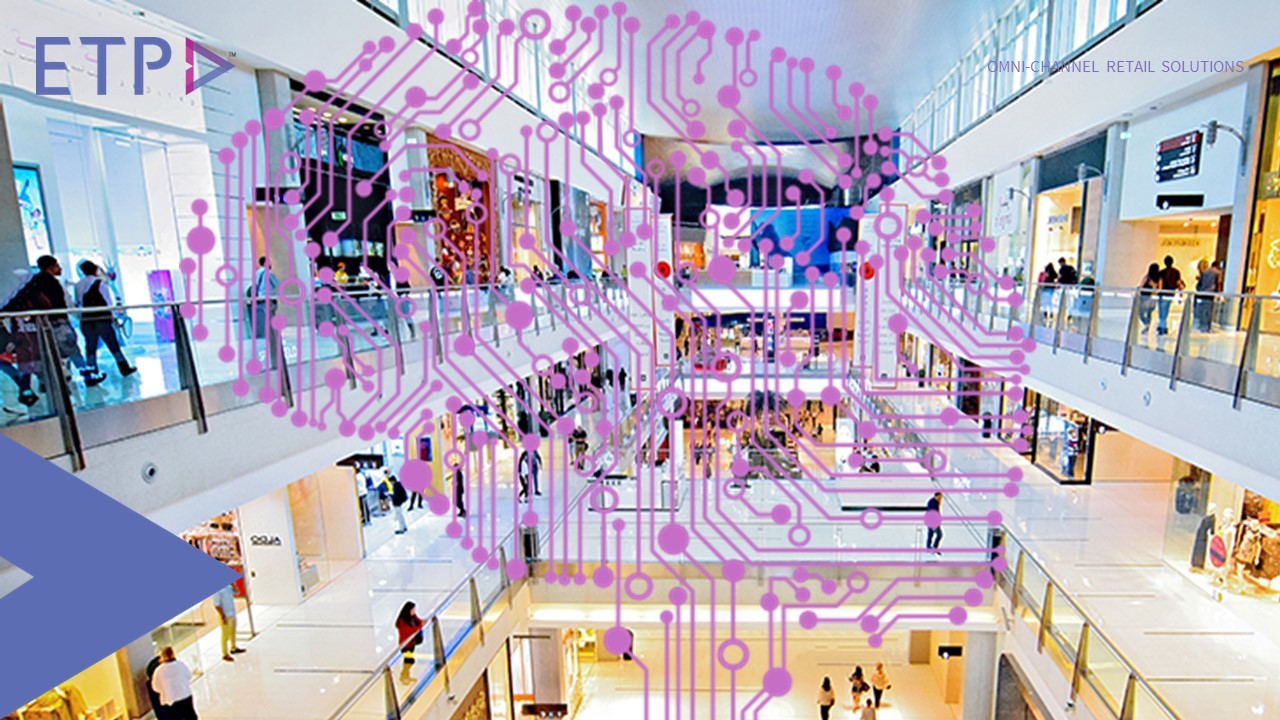
AI will also be able to help in actually predicting the purchasing behaviour as well as the needs of in-store customers. This means that sales staff can have this kind of information handy and will therefore have an idea of what a customer is looking to buy before they even ask for help. This will be a huge step in predicting the customers’ needs in advance and being able to serve them aptly thus revolutionizing customer service at the store.
AI driven insights would also be leveraged to not only design new product ranges but also to plan and create marketing and promotional campaigns and offers. Optimizing product pricing and discounting with the help of AI will prove to be beneficial to retailers. Further AI-backed demand forecasting is also increasingly becoming an essential tool for retailers. Understanding customer demand and accurately planning and managing inventory has become critical, especially during mega shopping events such as Black Friday, Cyber Monday, Singles Day and Chinese New Year. Demand forecasting with the help of AI will definitely empower retailers to be prepared for such big events in advance.
Mentioned above are some of the applications of Artificial Intelligence in the retail business and as time progresses, these applications may get further enhanced and there may be new ones that retailers may want to use and fuse into their businesses to further enhance their customer experience across channels.
Chinese New Year is the new mega shopping festival
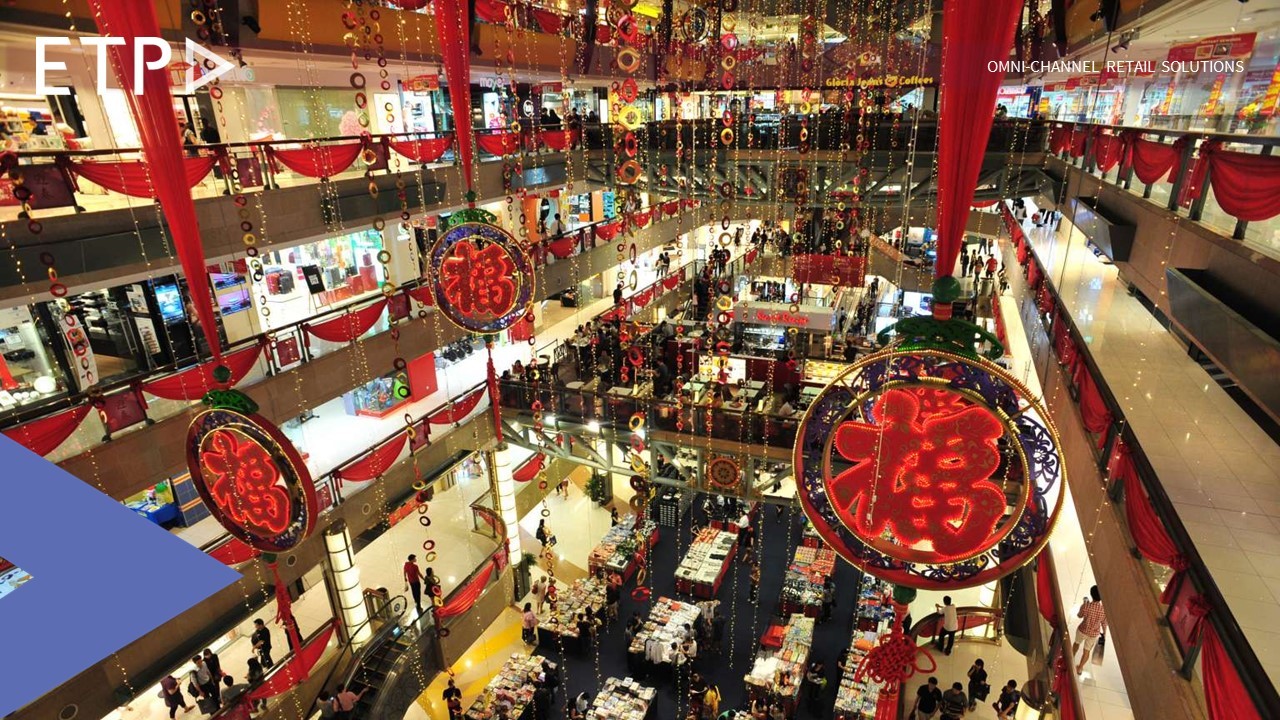
Friday, 16th February 2018 marks the beginning of the Chinese New Year. The 2018 Chinese New Year – the Year of the Dog begins nineteen days later than the Chinese New Year 2017, which started on January 28. Also known as Spring Festival in China, the Chinese/Lunar New Year (CNY) is the prime national holiday in Greater China. It is also celebrated in regions with a substantial Chinese population, particularly in South-East Asia and in the Chinatowns of cities worldwide, from Vancouver in Canada to London in UK to Lima in Peru. In China, the official holiday lasts seven days.
In the weeks leading up to the Chinese New Year, shoppers purchase across several categories in preparation for the Lunar New Year, with a sales uplift in average daily sales across fashion (71%), food and groceries (101%), and health and beauty (56%).
Many sales happen on mobile devices especially through the mobile apps. In Singapore and Vietnam, sales surge in the fashion sub vertical were 29% and 99% higher in-app than on mobile web, respectively.
Data from 2017 shows a 35% overall rise in daily online retail sales across Southeast Asia around two or three weeks before Chinese New Year, meaning marketers should start their campaigns 3-4 weeks before CNY to win new customers and maximize sales.
People are also looking for experiences. Travel sales pick up 2-3 weeks before Chinese New Year and even more so in the weeks after, especially for certain countries in the region. Three weeks before Chinese New Year shows an average increase of 33% in travel sales in Hong Kong, Taiwan, and Singapore. But a larger surge occurs after Chinese New Year across the region, when Vietnam and Hong Kong see a 75% and 70% increase in daily online travel sales, respectively.
Traditionally, the festival used to be about reunions within China, where many families were separated by work during the year. Millions of economic migrants, students, office workers and others made the annual exodus from their work locations to their hometowns, leading to one of the world’s biggest mass-transportation occasion. The relatively new idea that families can enjoy time together elsewhere is also gaining popularity. A number of countries, including France, UK and the US are easing visa regulations for Chinese nationals in order to lure a lucrative influx of free-spending travelers.
The Chinese New Year (CNY) opportunity is being increasingly explored by a number of international retailers globally as Chinese consumers continue to assert their global purchasing power. With the booming numbers of Chinese travelling during the CNY period and with retailers always on the lookout for new sales opportunities, a growing focus on this mega event similar to the likes of Black Friday is necessary.
In fact, the globalization of CNY fits into a wider trend, which is seeing the reach of once-local events and promotions extend across the globe. Previously, exclusively market-specific events such as Black Friday, Oktoberfest or Singles Day are increasingly being adopted internationally – due to increased travel, the growth of ecommerce and social media, and the globalization of media in general.
With this in mind, retailers everywhere will have to take CNY seriously. This could mean partnering with strong, authentic Chinese brands (providing them an opportunity to develop in new markets), as well as investing in in-store value added services such as hiring Chinese-speaking staff or having websites developed in Mandarin/Cantonese language and bespoke promotional material specifically targeted at these shoppers.
ETP #Futuretail, Bandung portrays the Omni-channel Transformation of Retail Businesses in Indonesia
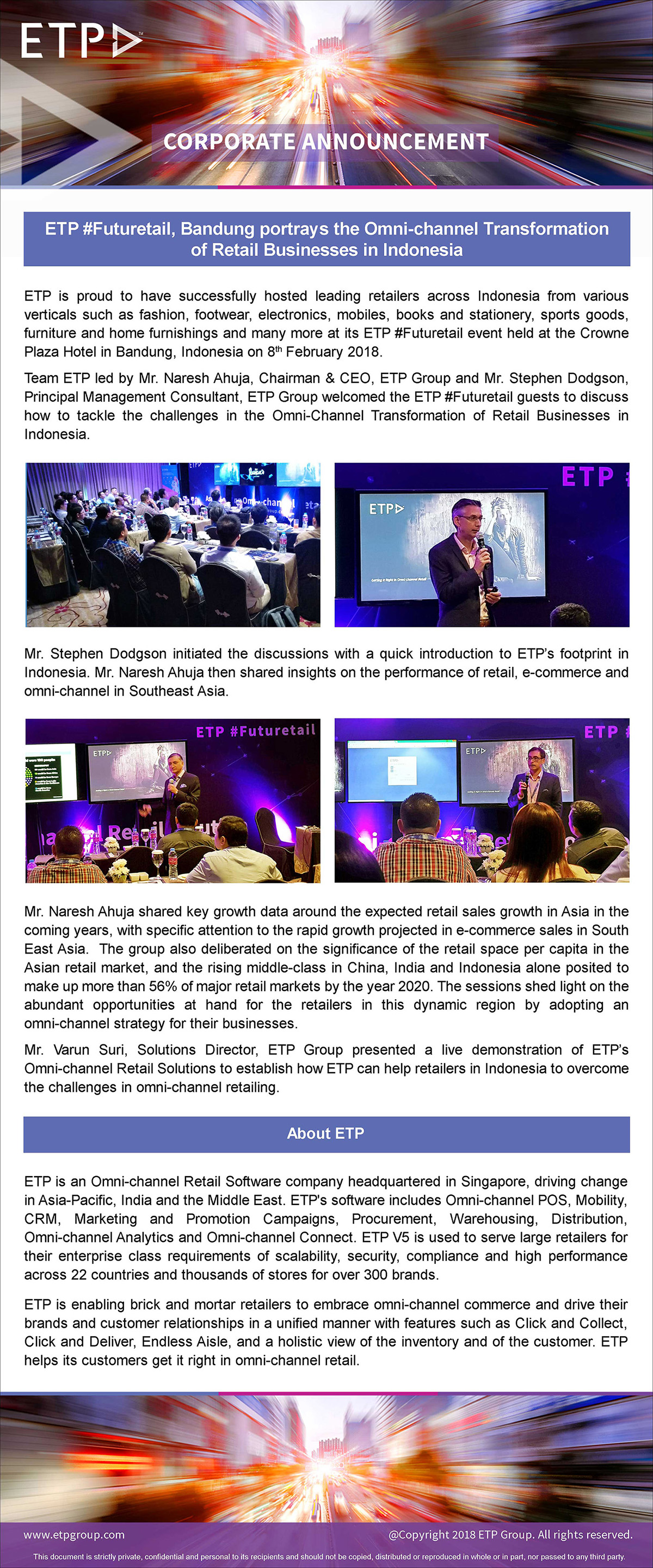
5 learnings for retail businesses from the SpaceX Falcon Heavy rocket launch
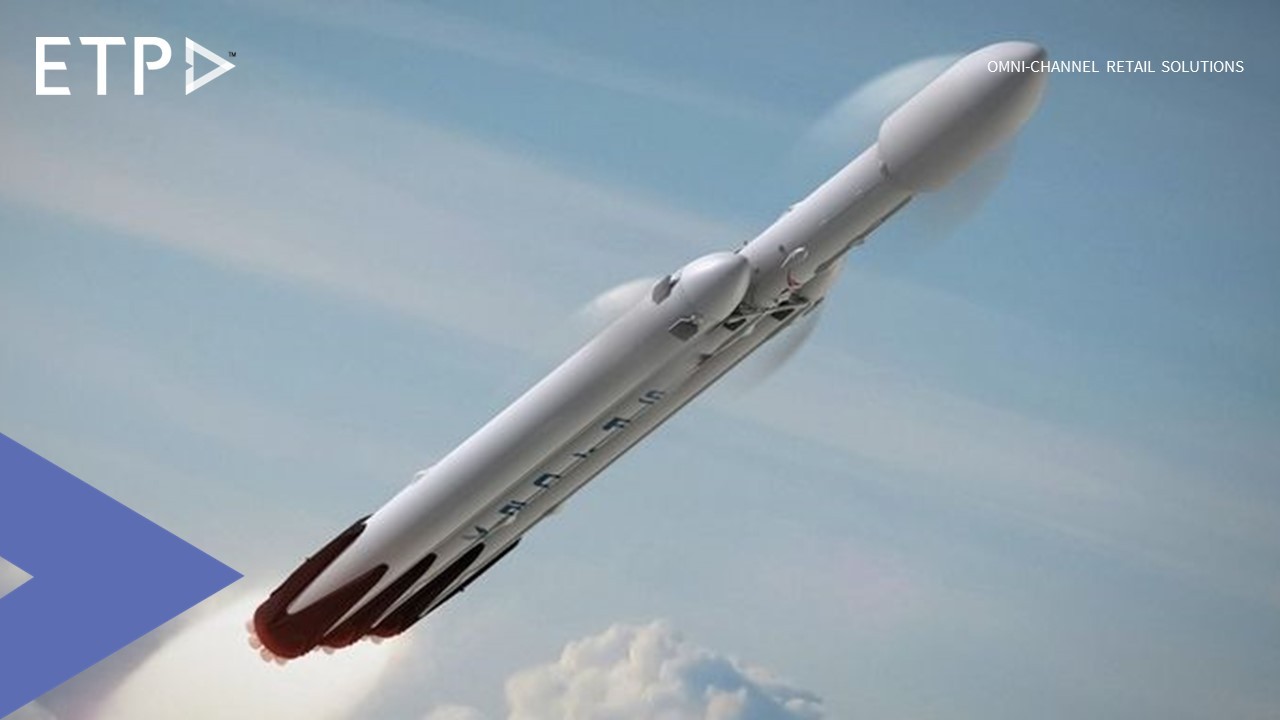
US entrepreneur and CEO of SpaceX, Elon Musk has successfully launched his new rocket, the Falcon Heavy, into space from the Kennedy Space Center in Florida and set the Tesla Roadster car into space. This would go into the history books as one of the biggest and most influential achievements by man.
From the same pad where NASA launched rockets that carried astronauts to the moon, a big, new American rocket called the Falcon Heavy, built by SpaceX, the company founded and run by the billionaire entrepreneur Elon Musk was launched successfully into space.
5 important learnings for retail and other businesses from this epic happening:
Think different
The Falcon Heavy is capable of lifting 140,000 pounds to low-Earth orbit, more than any other rocket today. Because the boosters are to be recovered to fly again, a Falcon Heavy launch costs not much more than one by the company’s existing rocket, Mr. Musk said. SpaceX’s Falcon Heavy is estimated to cost $90m per launch; Nasa’s planned SLS rocket, a comparable system, is expected to cost about $1bn per flight.
Retail businesses must look to be different than their peers and be able to create experiences that are different, not only from their competitors but also different for every customer, making it more personalized and customized for them.
Take risks and be ready for failure
Mr. Musk estimated that his company had spent more than half a billion dollars on Falcon Heavy and said that the program was almost canceled three times. It was billed as a risky test flight in advance of the lift-off. As the SpaceX CEO said the challenges of developing the new rocket meant the chances of a successful first outing might be only 50-50.
Retailers should not shy away from the risks that can manifest themselves while considering important technological transformations such as omni-channel, mobility and so on. They should be ready for that risk and be prepared for failures and then learn from these.
Strive for being better
Since 2010, SpaceX has been sending the smaller Falcon 9 rocket into orbit, deploying satellites and carrying cargo to crews aboard the International Space Station. The company has disrupted the global launch business with its lower prices and reusable boosters. However, taking the disruption further, the success gives SpaceX momentum to begin developing even larger rockets.
Retail businesses must look at trying to get better and not be contented with a business that works fine. They should constantly endeavor to enhance their businesses progressively to succeed in the long run.
Dream big and look towards the future
The successful launch of the Falcon Heavy into space seems to be the step in the right direction to fulfill Mr. Musk’s dream of sending people to Mars.
Retailers should always have the future in mind while doing business and setting goals that may seem to be big and unattainable. With that said, every effort to achieve these goals set in the future will help the retail businesses to proceed ahead.
Inspire with action
The success of launch of the Falcon Heavy is not the only historic achievement. This launch was historic in multiple other ways. For the first time ever, a pair of recycled boosters helped send a heavy payload to space. Only eight minutes later, those same two Falcon 9 side boosters returned and landed simultaneously at adjacent landing pads. This near flawless success is a major step toward cheaper, more frequent spaceflight, making it easier for governments and businesses to lift massive projects into space or set off on deep space missions.
Retail business owners must look to become leaders and pioneers in the industry and thus become a benchmark for other businesses not restricted to retail. This will help them achieve that status and stature which will be an example for others to egg and imbibe.
Omni-channel and the New Generation of Customers
In the following video, Mr. Neev Ahuja, Country Manager – India, ETP Group, representing the new generation of customers, shares his views and cues for retailers to keep pace with the demands of the new generation of customers and how omni-channel has been influential both on retailers and the new age shoppers.
What’s on retailers’ minds for 2018?
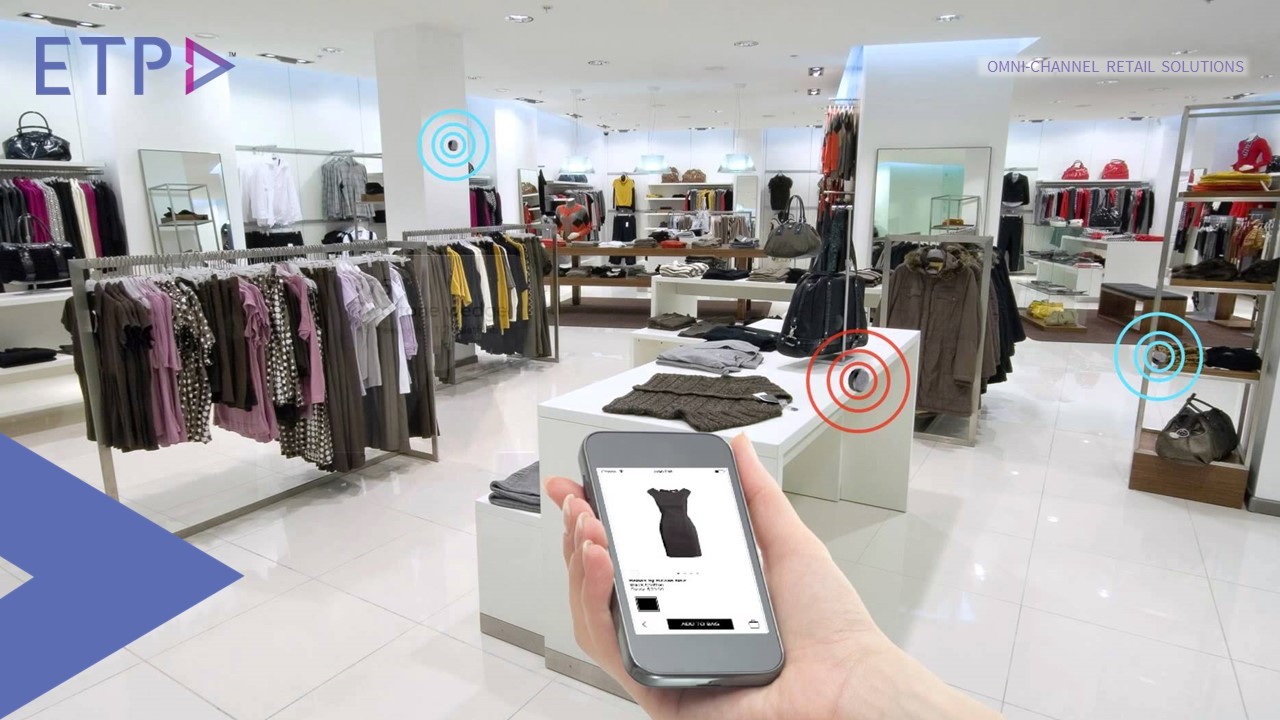
At the NRF Big Show 2018, retail executives and leaders share the areas they are going to focus on this year. Here are a few things they are working on:
1) Retailers will continue to strive for providing more personalized digital experiences.
When asked for views, executives from Macy’s, Neiman Marcus Group and The Children’s Place clearly stated that personalization would be a big focus for them in 2018. Macy’s is continuing to focus on personalization according to an executive, “The whole concept of personalization is simply on steroids right now. It’s all about the consumer in that one moment in time. We’re doing anything we can do to connect directly with consumers and make shopping convenient for them.”
Retailers have worked on improving personalization for many years but it all boils down to customer experience. As such, providing great customer experiences in 2018 will be the result of blending technology with a more personalized touch.
2) Connecting online and offline store experiences will remain a major focus.
Leading retailers such as Macy’s and The Children’s Place are still fervent on ‘omni-channel retail’. Macy’s is continuing to see serious growth in the area of “buy online, pick up in store” (BOPIS). Macy’s executive stated that “physical stores are not going away. Customers will always want the option of coming into the store to try on jeans instead of buying three different sizes online.”
The Children’s Place is also striving towards making it big in digital and using a lot of the omni-channel use cases like BOPIS and ‘Save the Sale’. ‘Save the Sale’ needs store associates to be able to access real-time inventory across the store network. This enables the store associates to address the situation of stock-out and lost sales by helping customers to find their desired item online or at another store location with ease.
3) More retailers will look to leverage voice assistants.
Global Chief eCommerce Officer at Samsonite feels that voice assistants will start taking off in certain categories like consumables. However, categories like fashion may have a harder time to leverage voice. 1-800-Flowers.com having been one of the first retailers to launch an Alexa skill, the CEO & President believes that bots and AI capabilities will enable 1-800-Flowers.com to amplify its personalized experience. He envisions the possibilities, “With voice as the main interface emerging, I think it will bring us back to the retail experience of our first flower shop where we delivered a true 1-to-1 relationship. Voice enables us to have a 1-to-1 relationship with customers on a massive scale.”
4) As artificial intelligence (AI) matures, AI-powered retail applications are gaining adoption.
According to the Global Chief eCommerce Officer at Samsonite, 2018 will be the year that artificial intelligence will have its breakthrough moment. Retailers will start using it to power various parts of the retail and eCommerce experience. 1-800-Flowers.com uses AI to power conversational interfaces like Alexa, Google Assistant and Facebook Messenger, many of which need no human touch at all.
Using AI and its applications in various aspects of retail, retailers are looking to boost their businesses and enhance customer experiences.
5) Personalization, social media and Amazon Marketing Services will be used as acquisition marketing strategies.
The Children’s Place highlighted the importance of personalized marketing strategies. Its personalization strategy began in 2017 when the company hired a data scientist to clean up the customer database. Now that The Children’s Place can connect customer purchases online and in-store, the executive believes that it will aid in making acquisition, engagement and retention strategies more personal,.
Social media also seems to be one of the top marketing priorities for the CEO of Petco. On the flip side, Global Chief eCommerce Officer at Samsonite believes, “Amazon Marketing is going to become as critical to a brand’s marketing strategy as Google and Facebook. Today, Amazon has the return on investment potential of Google Paid Search in 2005 and display ads in 2002.”
ETP is Omni-channel Technology Partner to HIPPINDO at the Modern Retail Expo 2017
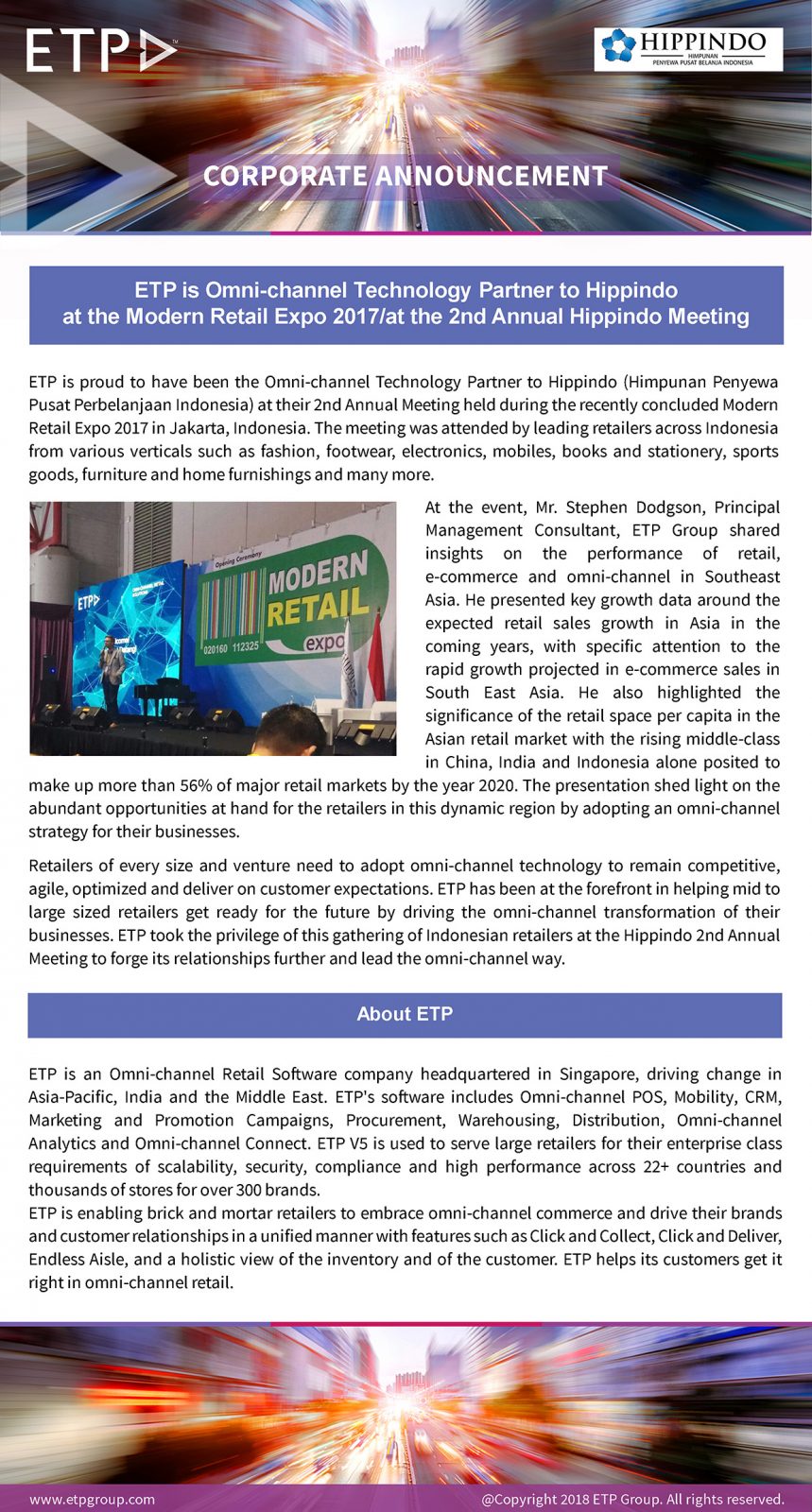
Are you bracing up for the future of retail and the Amazon onslaught? Omni-channel is the way to do it.
As the New Year 2018 is predicted to bring fortunes for retail businesses across the globe, retailers, both online and offline, continue to seek ways to slow Amazon’s dominant run in the retail landscape. And this seems to be the ‘need of the hour’ as Amazon, having already captured the online retail market has set its sights on offline retail in the last 2 years. Since 2015, the online giant has opened a half dozen bookstores as well as spent a whopping $13.7 billion on acquiring the Whole Foods chain in 2017. Amazon will continue this blitz in the coming years and look to burgeon its market share, thereby threatening other retailers’ success.
And whilst Amazon seeks to disrupt the retail space with its omni-channel prowess, many brands that were traditionally seen as pure-play brick-and-mortar retailers or pure-play online retailers have begun to expand their omni-channel presence and this trend will continue. However, in their endeavor to make it big, they will have to brace up for what lies ahead and the Amazon onslaught.
As customer service and customer experience is the battle ground for retailers’ survival, the basic fundamental is to focus on consumer expectations and to supersede those in ways better than the competition. The modern day consumer’s expectations live in both the online and offline worlds simultaneously.
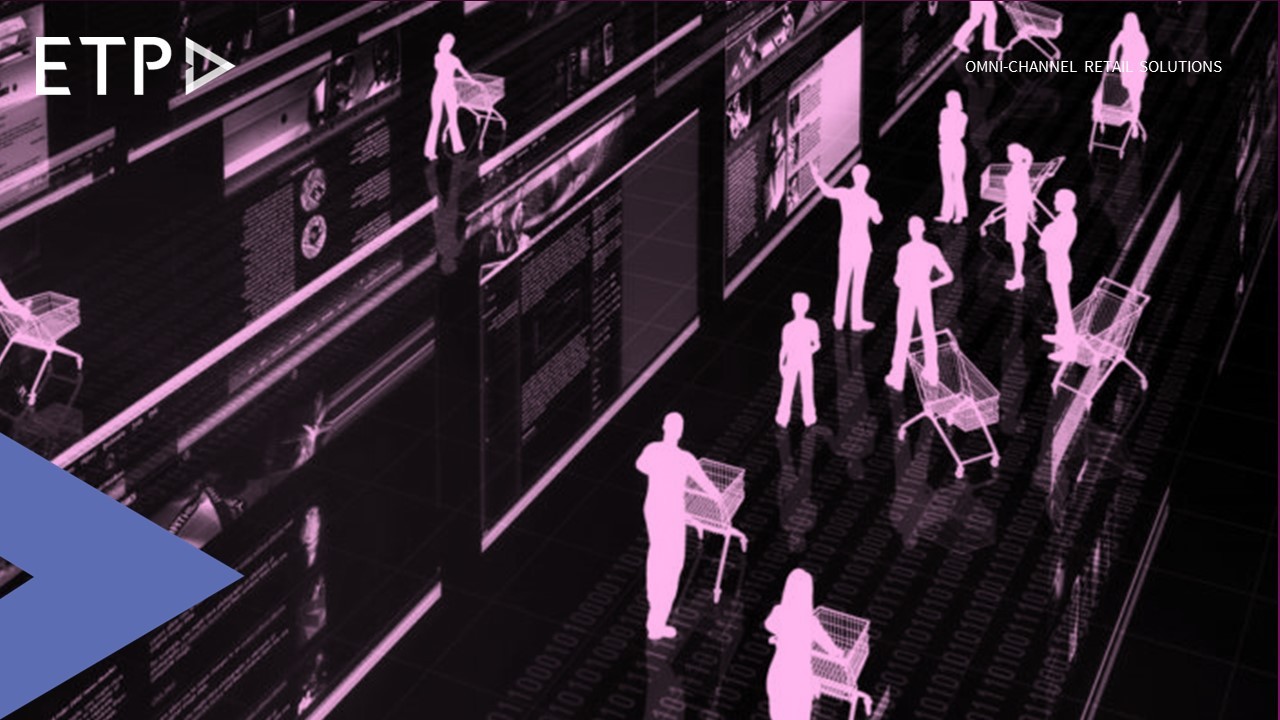
Below are four tactical ways retailers can address consumers’ expectations without further ado, offering the omni-channel experience that consumers will crave for more:
Integrating local in-store inventory with eCommerce
Imagine a scenario where a shopper headed to a birthday party realizes she needs to get a gift. With about an hour left for the party purchasing on Amazon is not an option. In this case, she could look to buy the gift from local store’s website and then pick it up on her way. This is an ideal case and that is the kind of service that brick-and-mortar retailers must look to offer while competing with Amazon and safeguarding their customer loyalty. The process uses both online and offline channels, and thus makes it a seamless omni-channel shopping experience.
Receiving returns in-store for online purchases
Another important advantage that brick-and-mortar retailers have over Amazon is that customers looking to return a product purchased online could just do it at the local store instead of mailing it back or waiting for someone to come and pick it up. Only having a truly omni-channel business can make this possible. Retailers can thus use the power of their own stores and online sites to impress their customers and beat the Amazon heat.
Ensuring information availability in-store
Having well-informed sales associates at the store will help retailers ring up more sales is obvious and there is a lot of scope for this. One of the ways of ensuring the sales associates are informed and ready is by equipping them with tablet devices carrying information related to the product such as availability price, offers, popularity, and information of the customer, such as purchase history, preferences and more. The devices can also have competitor related information regarding products, prices and promotions. With all this information they’ll be able to respond to any question a consumer throws at them. Moreover, extending this concept using an in-store kiosk or an interactive device where the customers can themselves browse and gather information will also help the cause greatly. These techniques will help retailers retain customer loyalty and compete with Amazon.
Using the stores beyond display and selling
At Apple Stores, customers can learn how to take better photos with their devices, learn the basics about operating their Macbooks and discover their use for art and design projects. The Home Depot hosts workshops for people keen to learn new carpentry skills. Some brands don’t even sell anything in their retail spaces. These are excellent examples of extending the real estate of the brick-and-mortar store as an opportunity to use this space for creating experience beyond just displaying products or selling. Additionally, retailers can use their online sites to inform customers about such happenings at the store. And this is one of the major advantage that brick-and-mortar retailers going omni-channel have over online players like Amazon.
These techniques may seem beyond the immediate capability of retailers. But the urgency to acquire these operational capabilities is real and unforgiving. If retailers want to be ready for the future and compete with Amazon but they continue doing business the way they have been, then it spells nothing but doom. Without the right omni-channel retail software solution, right from the Point-of-sale (POS) to the supply chain, retailers may end up being thrown out of business.

